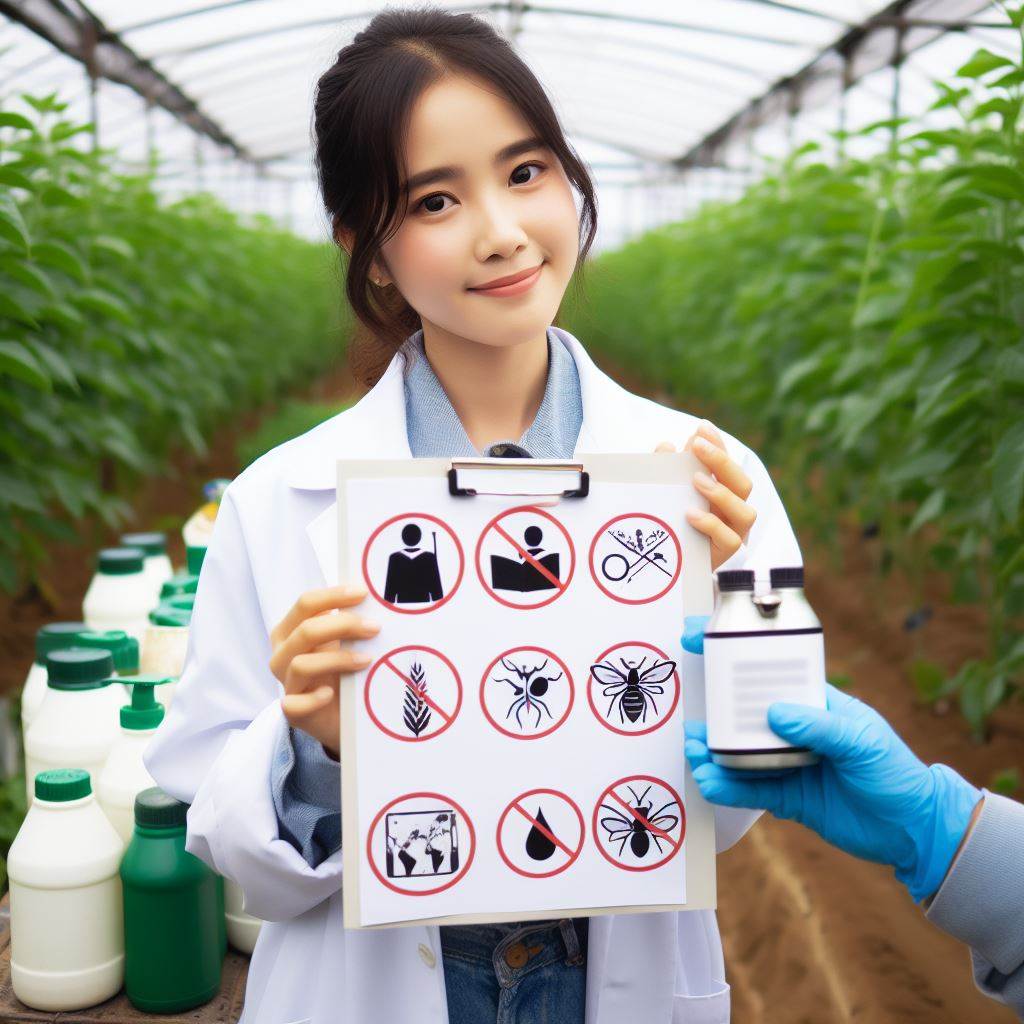Introduction
Importance of pesticide regulations in modern farming
Pesticide regulations play a crucial role in modern farming, ensuring the safety and sustainability of agricultural practices.
These regulations aim to control the use of pesticides to protect human health, the environment, and the overall quality of our food.
In this blog section, we will provide a brief overview of the topic, highlighting the importance of pesticide regulations in modern farming.
Pesticides, which include insecticides, herbicides, and fungicides, are widely used in agriculture to control pests, diseases, and weeds.
However, their indiscriminate and excessive use can have detrimental effects on the environment and human health.
Pesticide regulations are necessary to mitigate these risks and ensure that their usage is safe and responsible.
Brief overview of the topic
The primary objective of pesticide regulations is to protect human health by setting limits on pesticide residues in food and water.
These regulations establish Maximum Residue Limits (MRLs) that determine the maximum amount of pesticide residue allowed in food products.
Compliance with MRLs is critical to prevent potential health hazards associated with pesticide exposure, such as cancer and reproductive disorders.
Moreover, pesticide regulations aim to safeguard the environment by minimizing the adverse effects of pesticides on ecosystems and non-target organisms.
They set specific restrictions on pesticide application methods, dosages, and timing to prevent contamination of soil, air, and water resources.
By ensuring proper pesticide use, regulations help maintain biodiversity and protect beneficial insects, birds, and aquatic life.
Therefore, pesticide regulations are of utmost importance in modern farming to safeguard human health, protect the environment, and ensure sustainable agricultural practices.
These regulations are essential in promoting responsible pesticide use and maintaining the long-term viability of our food production systems.
In the following sections, we will delve deeper into specific aspects of pesticide regulations and their implications in modern farming.
Transform Your Agribusiness
Unlock your farm's potential with expert advice tailored to your needs. Get actionable steps that drive real results.
Get StartedHistorical background of pesticide regulations in farming
In order to understand the current state of pesticide regulations in modern farming, it is important to delve into the historical background of these regulations.
This section will explore the early use of pesticides in farming practices, the emergence of concerns regarding their environmental and health impact, and the introduction of pesticide regulations.
Furthermore, we will highlight the major milestones in the development of pesticide regulations.
Early use of pesticides in farming practices
- Farmers have been using pesticides for centuries to protect their crops from pests and increase yields.
- Historically, pesticides were often derived from natural sources such as plants and minerals.
- These early pesticides were effective, but their impact on the environment and human health was not fully understood.
Emergence of concerns regarding the environmental and health impact
- As industrialization took place, synthetic pesticides were developed, offering increased effectiveness and durability.
- However, concerns started to arise regarding the potential negative effects of these synthetic pesticides.
- Studies began to reveal their harm to the environment, including the contamination of water sources and the reduction of biodiversity.
- There were also growing concerns about the impact of pesticide residues on human health, particularly among farmworkers and consumers.
Introduction of pesticide regulations
- In response to these concerns, governments around the world started introducing pesticide regulations in the mid-20th century.
- The goals of these regulations were to ensure the safe use of pesticides and minimize their negative impacts.
- Regulations included guidelines for registration, labeling, storage, and application of pesticides.
- These regulations also aimed to monitor pesticide residues in food and establish maximum residue limits.
Major milestones in the development of pesticide regulations
- 1962: The United States passed the Federal Insecticide, Fungicide, and Rodenticide Act (FIFRA), establishing pesticide regulations.
- 1970: The Environmental Protection Agency (EPA) was founded in the United States to further regulate pesticides.
- 1987: The Montreal Protocol was adopted, aiming to phase out the production of ozone-depleting pesticides.
- 1992: The Stockholm Convention on Persistent Organic Pollutants (POPs) was signed, targeting the elimination or restriction of highly hazardous pesticides.
These milestones represent significant progress in the development of pesticide regulations, emphasizing the need for stricter control and safer alternatives.
However, challenges remain in effectively enforcing these regulations and balancing the benefits and risks associated with pesticide use.
Most importantly, understanding the historical background of pesticide regulations in farming is crucial to comprehend the current state of these regulations.
By acknowledging the early use of pesticides, the emergence of concerns about their environmental and health impact, and the subsequent introduction of regulations, we can better appreciate the efforts made to regulate pesticide use in modern farming practices.
Continued research and innovation are essential to ensure the safety of both agricultural productivity and the environment.
Read: Impact of Tax Laws on Family Farms
Key objectives of pesticide regulations in modern farming
Ensuring Food Safety and Quality
The first key objective of pesticide regulations in modern farming is to ensure food safety and quality.
These regulations are crucial to protect consumers from potential harm and maintain the integrity of the food supply chain.
Pesticides are widely used in farming to control pests, diseases, and weeds.
However, the improper use or excessive application of these chemicals can lead to residues in crops, posing risks to human health when consumed.
Therefore, regulations are in place to establish acceptable limits for pesticide residues in food and enforce their compliance.
Government agencies, such as the Food and Drug Administration (FDA) in the United States, have set maximum residue levels (MRLs) for various pesticides in different food products.
These MRLs are based on extensive scientific research and ensure that the levels of pesticide residues in food are safe for human consumption.
In addition to MRLs, regulations also require farmers and food producers to follow good agricultural practices (GAPs) to minimize pesticide application and employ safe handling and storage practices.
This helps in maintaining the quality and safety of food throughout the production and distribution process.
Protecting Human Health
Another crucial objective of pesticide regulations is to protect human health.
Pesticides, if not used properly, can have adverse effects on human beings, ranging from acute poisoning to long-term chronic health issues.
Regulations aim to prevent these potential risks by ensuring that only authorized pesticides are used in farming and that their application follows strict guidelines.
These guidelines include proper protective measures for farmers during pesticide handling and application, as well as restrictions on pesticide use near residential areas and schools.
Furthermore, pesticide regulations require rigorous testing and evaluation of new pesticides before they can be approved for commercial use.
This process assesses their potential toxicity and environmental impact, thus preventing the introduction of hazardous substances into the market.
Showcase Your Farming Business
Publish your professional farming services profile on our blog for a one-time fee of $200 and reach a dedicated audience of farmers and agribusiness owners.
Publish Your ProfileMinimizing Environmental Impact
Reducing the environmental impact of pesticide use is another key objective of regulations in modern farming.
Pesticides, when released into the environment, can contaminate water bodies, harm beneficial insects, and disrupt ecosystems.
To minimize these impacts, regulations promote the use of integrated pest management (IPM) strategies.
IPM focuses on the prevention of pests through crop rotation, biological controls, and cultural practices.
Pesticides are used as a last resort and only when necessary.
Furthermore, regulations require farmers to adhere to buffer zones near water sources to prevent pesticide runoff.
Additionally, regulations encourage the development and use of less toxic or environmentally friendly alternatives to conventional pesticides.
This includes biopesticides, which are derived from natural sources and have minimal impact on non-target organisms and the environment.
Promoting Sustainable Agriculture
Pesticide regulations also have the objective of promoting sustainable agriculture.
Sustainable farming practices aim to minimize the reliance on pesticides, reduce environmental degradation, and ensure the long-term viability of agricultural systems.
Regulations support sustainable agriculture by incentivizing farmers to adopt organic and agroecological approaches.
Organic farming prohibits the use of synthetic pesticides, while agroecology focuses on ecological principles to manage pests and diseases naturally.
These practices help maintain soil health, biodiversity, and the overall resilience of farming ecosystems.
Furthermore, regulations often provide support and resources for farmers to transition to sustainable farming methods.
This includes funding for research and education on innovative pest management techniques, as well as financial incentives and certification programs for organic and sustainable farming practices.
In essence, pesticide regulations in modern farming have several key objectives.
They aim to ensure food safety and quality, protect human health, minimize environmental impact, and promote sustainable agriculture.
By achieving these objectives, these regulations contribute to a healthier and more sustainable food system for present and future generations.
Read: Farmland Preservation Policies Today
Government agencies responsible for pesticide regulations
Government agencies play a crucial role in the regulation of pesticides in modern farming.
These agencies are responsible for overseeing and enforcing regulations to ensure the safe and proper use of pesticides.
In this section, we will provide an overview of the major government agencies involved, their roles and responsibilities, as well as the collaboration and coordination among them.
Overview of major government agencies involved
- The Environmental Protection Agency (EPA): The EPA is the primary federal agency responsible for regulating pesticides in the United States.
- The Department of Agriculture (USDA): The USDA oversees the agricultural industry, including the regulation of pesticides used in farming.
- The Food and Drug Administration (FDA): The FDA is responsible for ensuring the safety of pesticide residues in food and agricultural products.
Roles and responsibilities of each agency
The EPA plays a pivotal role in pesticide regulation by registering pesticides, establishing tolerance levels for residues, and reviewing the safety and effectiveness of pesticides.
They also enforce compliance with pesticide regulations and conduct risk assessments to evaluate the potential risks associated with pesticide use.
The USDA’s responsibilities lie in ensuring the proper use of pesticides in agriculture.
They provide guidance to farmers and conduct research to develop effective pest management practices.
The USDA also monitors and enforces compliance with pesticide regulations, particularly in relation to the production and export of agricultural products.
The FDA focuses on pesticide residues in food and agricultural products.
They establish tolerance levels for pesticide residues and ensure that these residues do not pose any significant health risks to consumers.
The FDA conducts regular inspections and sampling to enforce compliance with pesticide regulations and takes appropriate action if violations are found.
Collaboration and coordination among different agencies
To effectively regulate pesticide use, these government agencies work together in coordinating their efforts.
They share information, expertise, and resources to ensure a collaborative approach to pesticide regulation.
The EPA, USDA, and FDA often collaborate on issues related to pesticide regulation, such as establishing maximum residue limits, conducting joint research projects, and sharing data on pesticide safety and effectiveness.
This collaboration ensures a coordinated approach to addressing the potential risks associated with pesticide use and protecting public health and the environment.
Additionally, these agencies collaborate with state regulatory agencies, academic institutions, and other stakeholders to gather diverse perspectives and expertise.
This broader collaboration helps in the development and implementation of regulations that are science-based, practical, and responsive to the needs of various stakeholders.
In fact, government agencies working together play a crucial role in pesticide regulation in modern farming.
The EPA, USDA, and FDA each have unique roles and responsibilities to ensure the safety and proper use of pesticides.
Through their collaboration and coordination, these agencies contribute to the development and implementation of effective pesticide regulations, protecting the environment and ensuring the safety of agricultural products for consumers.
Read: 2024 Organic Farming Standards Explained
Showcase Your Farming Business
Publish your professional farming services profile on our blog for a one-time fee of $200 and reach a dedicated audience of farmers and agribusiness owners.
Publish Your Profile
Types of Pesticides Regulated in Modern Farming
When it comes to pesticide regulations in modern farming, it is essential to understand the different types of pesticides that are regulated.
Pesticides are chemicals used to protect crops from various pests, such as insects, weeds, and fungi.
Here are the key types of pesticides regulated in modern farming:
Classification Based on Chemical Composition
- Inorganic Pesticides: These are pesticides that contain elements other than carbon, such as sulfur, copper, or arsenic.
- Organic Pesticides: These are pesticides that consist of carbon compounds, such as pyrethroids derived from chrysanthemums or neem oil.
- Synthetic Pesticides: These are pesticides that are human-made, often created through chemical synthesis.
Differentiating Between Herbicides, Insecticides, Fungicides, etc.
Based on the target pest, pesticides are further categorized into specific types:
- Herbicides: These pesticides are designed to control or eliminate weeds, which compete with crops for nutrients, water, and sunlight.
- Insecticides: These are pesticides formulated to combat insects that damage crops by feeding on leaves, stems, or roots.
- Fungicides: Fungicides are used to prevent or inhibit the growth of fungi that cause diseases in crops.
- Bactericides: These pesticides are effective against bacteria that can infect or damage crops.
- Nematicides: Nematicides are used to control nematodes, which are microscopic worms that can harm plant roots.
- Rodenticides: These pesticides are employed to control rodents that can cause significant damage to crops.
Commonly Used Pesticides and Their Controlled Application
Regulations also focus on specific pesticides commonly used in modern farming practices.
Some examples include:
- Glyphosate: This herbicide is widely used to control unwanted weeds and grasses that compete with crops.
- Chlorpyrifos: An insecticide used against a variety of pests such as ants, termites, mosquitoes, and ticks.
- Mancozeb: This fungicide is effective in preventing and managing fungal diseases in vegetables, fruits, and field crops.
- Imidacloprid: A systemic insecticide utilized to control sucking insects like aphids, termites, and fleas.
- Malathion: This insecticide is commonly used to control pests in agricultural settings and urban environments.
- Bacillus thuringiensis (Bt): A biopesticide containing bacteria effective against certain insect pests.
It is important to note that the application of these pesticides must adhere to strict regulations to ensure their safe and responsible use.
Farming practices must follow instructions on use, dosage, timing, and safety precautions provided by regulatory authorities.
Basically, modern farming involves the regulation of various types of pesticides based on their chemical composition and target pests.
Understanding these different types and their controlled application is crucial for sustainable and responsible farming practices.
Read: Tax Strategies for Diversified Farms
Pesticide registration and approval process
The pesticide registration and approval process is a crucial step in ensuring the safety and effectiveness of pesticides used in modern farming practices.
This process involves several key components, including requirements for pesticide manufacturers, testing and data review, evaluation of potential risks and benefits, and a timeline for approval and registration.
Requirements for pesticide manufacturers
Pesticide manufacturers have to comply with specific requirements to register and sell their products.
These requirements aim to ensure that manufacturers adhere to quality standards and produce safe and effective pesticides.
Some common requirements include:
- Submission of detailed information about the pesticide, including its chemical composition, manufacturing process, and intended use.
- Demonstration of good manufacturing practices to guarantee consistency and quality of the pesticide.
- Compliance with labeling and packaging requirements to provide accurate information and prevent misuse.
- Investigation and reporting of adverse effects associated with pesticide use.
By imposing these requirements, regulatory agencies can hold pesticide manufacturers accountable for the safety and quality of their products.
Testing and data review
Before a pesticide can be approved and registered, extensive testing and data review are conducted to evaluate its efficacy and safety.
Pesticide manufacturers are responsible for conducting these studies and submitting the data to regulatory agencies.
The testing process typically includes:
- Laboratory experiments to determine the pesticide’s effectiveness against target pests.
- Field trials to assess its performance under realistic conditions and evaluate any potential environmental impacts.
- Toxicology studies to identify potential effects on human health and non-target organisms.
- Ecotoxicology studies to evaluate its impact on the environment, including water sources, wildlife, and beneficial insects.
Regulatory agencies review the submitted data to ensure that the pesticide meets efficacy standards while minimizing risks to human health and the environment.
Evaluation of potential risks and benefits
Prior to approval, regulatory agencies conduct a thorough evaluation of the potential risks and benefits associated with a pesticide’s use.
This evaluation considers various factors, including:
- The effectiveness of the pesticide in controlling the target pest.
- Potential impacts on non-target organisms, such as beneficial insects, birds, or aquatic life.
- Possible residues and their effects on food safety and consumer health.
- The persistence and mobility of the pesticide in the environment.
- Any potential long-term risks, such as the development of resistance in target pests.
By weighing these factors, regulatory agencies can make informed decisions regarding the safe use of pesticides in farming practices.
Timeline for approval and registration
The approval and registration process for pesticides can be lengthy and complex.
The timeline may vary depending on factors such as the pesticide’s complexity, availability of data, and public input.
On average, the process can take several years.
It typically involves the following steps:
- Preliminary review of the manufacturer’s submission and initial assessment of the pesticide’s potential risks and benefits.
- Public notification and comment period to gather feedback, concerns, and additional data from stakeholders.
- Further evaluation of additional data and refinement of the risk assessment.
- Final decision on approval or denial of pesticide registration, accompanied by specific conditions or restrictions if needed.
By adhering to a systematic timeline, regulatory agencies ensure a thorough and evidence-based evaluation of pesticide products.
Essentially, the pesticide registration and approval process involves stringent requirements for manufacturers, rigorous testing and data review, evaluation of risks and benefits, and a defined timeline for approval and registration.
This process aims to ensure the safety and effectiveness of pesticides used in modern farming practices, ultimately safeguarding both human health and the environment.
Compliance and enforcement of pesticide regulations
Compliance and enforcement of pesticide regulations play a crucial role in modern farming.
To ensure the safe and responsible use of pesticides, monitoring and surveillance are conducted by regulatory authorities.
Monitoring and surveillance of pesticide usage – Inspections and audits
Monitoring and surveillance of pesticide usage involve collecting data on the types and quantities of pesticides used, as well as the methods of application.
This data helps identify any potential risks or violations of regulations.
Inspections and audits are conducted regularly to assess compliance with pesticide regulations.
Inspectors visit farms and agricultural facilities to check records, observe practices, and ensure proper handling and storage of pesticides.
During inspections, inspectors may also collect samples of crops, soil, water, or pesticide residues for laboratory testing.
These tests help determine if pesticide usage has exceeded permissible levels or if any banned or restricted pesticides have been used.
Consequences for non-compliance with regulations
The consequences for non-compliance with pesticide regulations can be severe.
Showcase Your Farming Business
Publish your professional farming services profile on our blog for a one-time fee of $200 and reach a dedicated audience of farmers and agribusiness owners.
Publish Your ProfileFarms found in violation may face legal action, penalties, or even the suspension of their farming operations.
Penalties for non-compliance can include fines, revocation of licenses, or the requirement to undergo mandatory training on pesticide safety and regulations.
In extreme cases of non-compliance or repeated offenses, criminal charges may be filed against individuals or farming entities responsible for the violations.
To encourage compliance, regulatory authorities often provide educational programs and resources to farmers.
These programs aim to raise awareness about the importance of pesticide regulations and provide guidance on best practices for their application.
In addition to regulatory oversight, farmers themselves also have a responsibility to comply with pesticide regulations.
They should stay updated on the latest regulations, receive proper training, and maintain accurate records of pesticide usage.
Compliance with pesticide regulations not only ensures the safety of crops and the environment but also protects the health of farmers, farm workers, and consumers who consume agricultural products.
In review, compliance and enforcement are crucial aspects of pesticide regulations in modern farming.
Through monitoring, inspections, and audits, regulatory authorities aim to ensure the proper use of pesticides and identify any violations.
The consequences for non-compliance can be severe, emphasizing the importance of adhering to regulations.
Ultimately, compliance with pesticide regulations contributes to sustainable and responsible farming practices.
Challenges and Controversies Surrounding Pesticide Regulations
In modern farming, pesticide regulations aim to strike a delicate balance between effective pest control and minimizing associated risks.
Balancing the Need for Pest Control and Minimizing Risks
Farmers face the challenge of ensuring food security by effectively controlling pests while minimizing potential risks to human health and the environment.
The development and enforcement of pesticide regulations are essential to prevent unreasonable and excessive pesticide use.
It is vital to find alternatives, such as integrated pest management, to reduce reliance on chemical pesticides and their potential adverse effects.
Resistance and Tolerance Development in Pests
One major concern regarding pesticide use is the development of resistance and tolerance in target pests.
Sustained exposure to pesticides can lead to the evolution of resistant populations, rendering certain chemicals ineffective over time.
This necessitates the continuous development of new pesticides and the implementation of effective resistance management strategies.
Ecological Impacts on Non-Target Organisms
Pesticides, while designed to target specific pests, often have unintended consequences on non-target organisms within ecosystems.
These chemicals can harm beneficial insects, such as pollinators like bees, as well as birds, fish, and other wildlife.
Stricter pesticide regulations should focus on assessing and mitigating the potential ecological impacts to preserve biodiversity and ecosystem health.
Public Perception and Concerns about Pesticide Use
Public perception plays a significant role in shaping pesticide regulations as concerns about the impact of pesticide use on human health increase.
Certain pesticides have been linked to adverse health effects, including carcinogenicity and developmental disorders.
Public pressure drives policymakers to reconsider regulations, promoting the use of safer alternatives and more transparent information on pesticide labels.
The challenges surrounding pesticide regulations in modern farming require a comprehensive and proactive approach.
Efforts should focus on achieving a balance between pest control and minimizing risks, addressing resistance development, and understanding ecological impacts.
Moreover, acknowledging public concerns and encouraging sustainable farming practices will pave the way for a healthier and more environmentally friendly agricultural industry.
Future outlook and advancements in pesticide regulations
In order to address the growing concerns over the use of conventional pesticides in modern farming, various advancements and initiatives are being undertaken globally.
This section will focus on emerging technologies and alternatives to conventional pesticides, policy reforms and adaptation to changing agricultural practices, and international collaborations and standardization efforts.
Emerging technologies and alternatives to conventional pesticides
- Biological control methods utilizing natural enemies of pests such as predators and parasitoids.
- Genetic engineering to develop crop varieties with built-in pest resistance mechanisms.
- Nanotechnology-based solutions for targeted delivery of pesticides, reducing environmental impact.
- Integrated Pest Management (IPM) strategies that combine various pest control methods.
- Use of pheromone traps and attractants to disrupt pest mating and breeding patterns.
Policy reforms and adaptation to changing agricultural practices
- Implementation of stricter regulations regarding the registration and use of pesticides.
- Encouraging farmers to adopt sustainable practices and reduce reliance on chemical pesticides.
- Strengthening farmer training programs to educate them about the responsible use of pesticides.
- Supporting organic farming practices and offering incentives for farmers transitioning to organic methods.
- Developing monitoring systems to track the effects of pesticide use on human health and the environment.
International collaborations and standardization efforts
- Establishing international partnerships to share knowledge and best practices in pesticide regulations.
- Developing global standards for the safe use and handling of pesticides.
- Encouraging information exchange between countries to improve risk assessment and risk management practices.
- Collaborative research projects aimed at finding new alternatives to hazardous pesticides.
- Creating awareness campaigns to educate consumers about the importance of pesticide regulation.
In short, the future outlook for pesticide regulations in modern farming looks promising with the emergence of new technologies and alternatives to conventional pesticides.
Policy reforms and adaptation to changing agricultural practices are essential to promote sustainable farming methods.
International collaborations and standardization efforts are crucial in addressing pesticide-related challenges on a global scale.
By working together, stakeholders can ensure the safe and responsible use of pesticides while minimizing their negative impacts on human health and the environment.
Conclusion
Pesticide regulations play a crucial role in modern farming.
They ensure the safety of consumers and protect the environment from adverse effects of harmful pesticides.
Continued research and improvements in regulations are essential to address emerging challenges and find more sustainable pest management solutions.
It is imperative for farmers, consumers, and policymakers to remain informed about pesticide regulations and understand their impact on farming practices.
By staying informed and advocating for responsible pesticide use, we can contribute to the development of better regulations that support safe and sustainable farming methods.
Together, let’s promote a balance between effective pest control and the protection of human health and the environment.
Showcase Your Farming Business
Publish your professional farming services profile on our blog for a one-time fee of $200 and reach a dedicated audience of farmers and agribusiness owners.
Publish Your Profile



